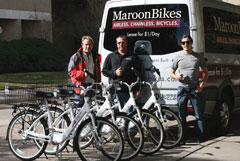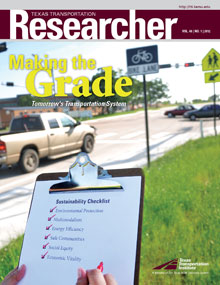Beacons, Pavement Markings Improve Crosswalk Safety
It can feel like you’re taking your life into your own hands when you cross some of Texas’ wide, high-speed roads. Sometimes the only thing that alerts drivers to a crosswalk is the thin white lines on the pavement. That’s not much to stand between you and a vehicle hurtling toward you.
Researchers at the Texas Transportation Institute (TTI) are trying to make things easier for both you and the driver coming toward you. Two recent research studies on pedestrian crossings have aimed at making crosswalks safer and more efficient. The first study, involving pedestrian hybrid beacons, evaluated crash data before and after installation of the treatment, while the second study examined the visibility of different types of crosswalk pavement markings.
“Both studies are influencing national standards and making conditions better for pedestrians,” says Kay Fitzpatrick, manager of TTI’s Roadway Design Program, who led the studies.
Pedestrian Hybrid Beacon
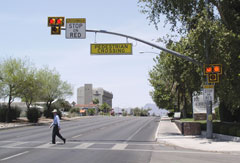
In 2009, the pedestrian hybrid beacon was added to the national Manual on Uniform Traffic Control Devices (MUTCD), the Federal Highway Administration (FHWA) document that defines standards for installing and maintaining traffic control devices on public roadways. TTI had an integral role in getting the device recognized for the safety it brings to pedestrian crossings.
The path to getting the safety device included in the manual began in the late 1990s when Dr. Richard Nassi, transportation administrator with the City of Tucson (now retired), developed the predecessor of the pedestrian hybrid beacon, the High-Intensity Activated Crosswalk (HAWK) pedestrian beacon. Today’s pedestrian hybrid beacon, like the HAWK treatment, has more than one cue to alert drivers to the presence of the crosswalk. At the crosswalk, the pedestrian pushes a button and activates the beacon. A flashing yellow light and then a steady yellow light warn drivers that they will need to stop. When the light turns red, the pedestrian can safely cross the street.
The effort to gain widespread use of the pedestrian hybrid beacon culminated in an FHWA study to evaluate the safety effectiveness of the device. TTI performed a before-and-after study to determine how the device actually worked in the field.
“We performed a statistical evaluation of crash data from Tucson, typically three years before installation of the treatment and then three years after installation,” says Fitzpatrick. “We found a 29 percent reduction in total crashes and a 69 percent reduction in pedestrian crashes.”
This dramatic reduction in crashes proved to FHWA how important the pedestrian hybrid beacon can be to pedestrian safety. “Many agencies are afraid to try new devices because of the possibility of increased crashes. TTI’s crash study showed that the pedestrian hybrid beacon reduced not only pedestrian crashes but also total crashes, making agencies more willing to try the device and invest money in it. You can depend on the quality of the work done at TTI,” says Mike Cynecki, retired traffic engineering supervisor with the City of Phoenix.
“We’re helping change national policies to make it safer for pedestrians, and also to make it easier for them to cross at clearly marked crosswalks,” says Fitzpatrick.
Crosswalk Markings
A second TTI study evaluated pavement markings at crosswalks for possible inclusion in the next edition of the MUTCD. Research focused on determining the relative daytime and nighttime visibility of crosswalk marking patterns.
“We looked at the types of markings currently in use at crosswalks and narrowed our focus down to the three most common patterns for investigation,” says Fitzpatrick. “We were very fortunate that Texas A&M University allowed us to place temporary pavement markings around campus as part of this study.”
Volunteer drivers set out in TTI’s instrumented vehicle, drove through campus on a predetermined route, and told the accompanying researcher the moment they first saw the crosswalk pavement markings. The route was driven during daytime and nighttime, and clockwise and counterclockwise, to reduce possible bias.
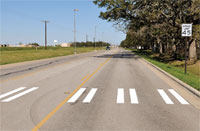
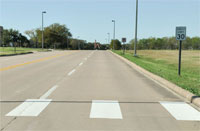
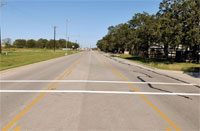
The resulting data allowed the research team to calculate the detection distance for each crosswalk and then determine how each type of treatment performed.
“Bar pairs and continental markings were visible from a longer distance than transverse markings,” says Fitzpatrick. “This is intuitive because they’re wider than transverse markings. What we were interested to see is that bar pairs performed as well as continental markings. Bar pairs use less marking material, and that can save agencies significantly over several crosswalks.”
The research effort was so successful that a paper about it won the D. Grant Mickle Award for the outstanding paper in operations and maintenance at the Transportation Research Board’s 90th Annual Meeting in January. (See the “TTI at TRB” article for more information about this award.)

